Daiwa's Air Brake System makes it virtually impossible to backlash a baitcaster. Whether you're new to casting tackle or a salty veteran, this is a feature you want in your reel.
More...
It's true, those anglers using casting tackle enjoy an advantage over those who don't:
Q: So why doesn't everyone use a baitcaster?
A: Because they fear that show-stopping backlash.
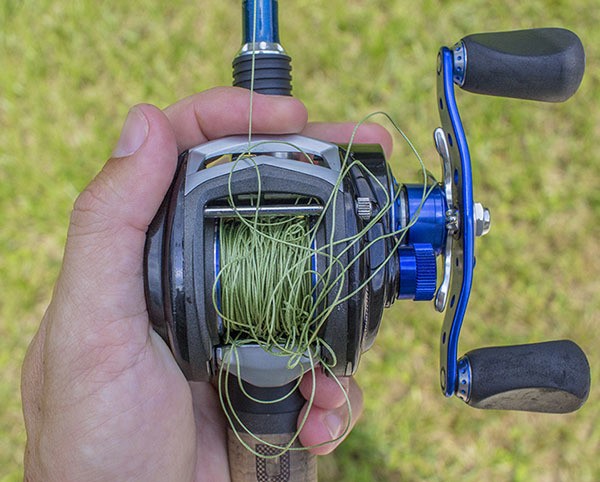
If they knew about Daiwa's Air Brake System they wouldn't worry about backlash in the first place.
What is Daiwa's Air Brake System?
It's a specialized magnetic braking system that improves casting performance from beginning to end.
In fact, it's based upon the proven MagForce Z (but with a few tweaks) and isn't offered by another other manufacturer.
But there's more to it than that, so let's jump into how this system works and how it benefits you.
What makes this brake system so great?
To answer this question you must first understand that there are two main types of casting brakes: centrifugal and magnetic.
In fact, I've detailed the differences between the two inside this article (inshore anglers use it to make good purchasing decisions) and always found that centrifugal brakes tend to perform the best.
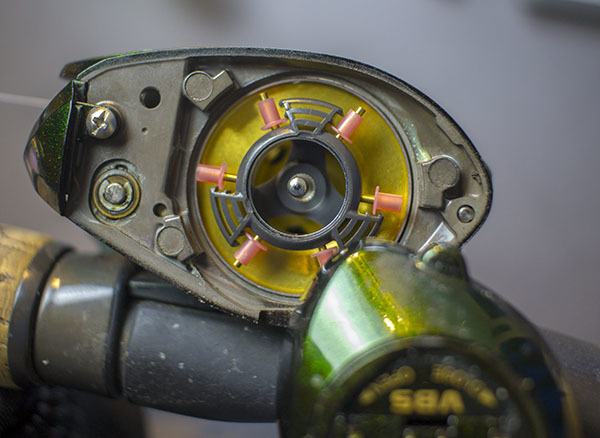
Shimano's Variable Braking System (VBS) set the standard for braking performance, and I feel Daiwa's Air Brakes exceed that standard.
So, I couldn't help but squirm upon learning the Tatula series of reels have magnetic brakes, because all I could think of was picking out the backlash that haunts the "meh" performance of magnets.
Boy, was I wrong.
Yes, Tatula reels have magnetic brakes, but not the conventional, glued-in type we see in entry level reels.
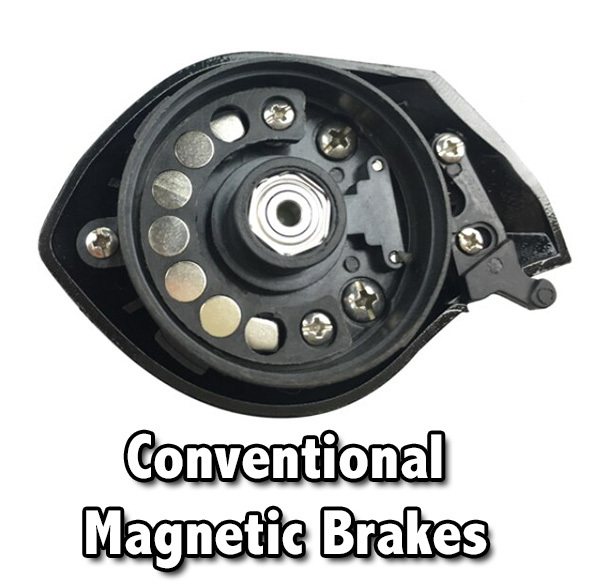
Why I Don't Like Conventional Magnetic Brakes
The idea behind brakes on a casting reel is to reduce RPMs in order to avoid the spool outpacing the bait during a cast, without reducing the casting distance.
Too little brake and you backlash, but too much brake and casting distance is reduced.
So you want to have a brake system that will slow down the spool when it's moving too fast, but let it continue to spin to pay out as much line as possible...
...so the lure can fly as far as possible...
...as smoothly as possible.
Centrifugal brakes achieve this by applying more braking power in the beginning of the cast and less towards the end.
Conventional magnetic brakes really don't, instead applying the same magnetic force to the spool throughout the entire cast, so they're really not "smart" compared to their centrifugal cousins.
Daiwa's Ingenious Solution
The Air Brake System is not so dull and boring because it's engineered using a design not seen in other reels.
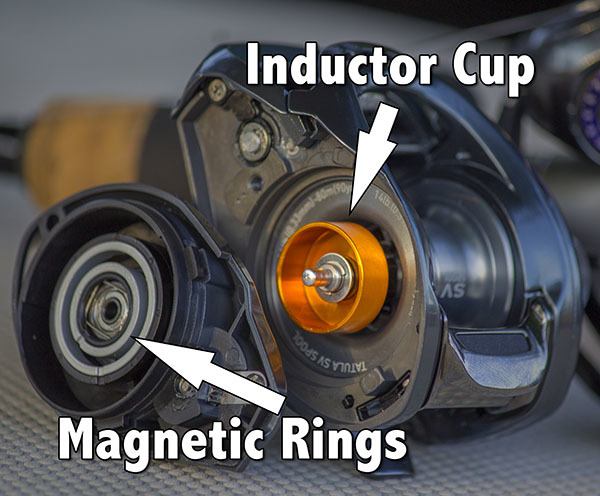
This is Daiwa's Air Brake System, and it consists of a spring loaded inductor cup and two adjustable magnetic rings.
How It Works
Let me explain, as simply as possible, how Daiwa's Air Brake System works, from beginning to end.
Start of Cast
At the very beginning of a cast there is no braking power applied to the spool at all.
This allows the spool to spin lightning fast in the split second your thumb comes off the spool and the lure begins flying towards its destination.
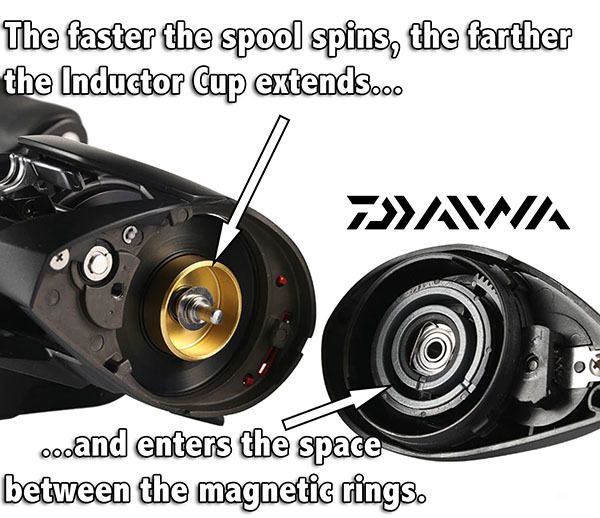
Mid Cast
Then the centrifugal force of the spool overcomes the spring holding the cup back, causing it to enter the magnetic field of the two rings, ultimately applying braking power where it's needed at max RPM.
As spool RPMs decrease, the spring gradually pushes the inductor cup out of the magnetic rings, evenly reducing braking power.
End of Cast
Finally, the RPMs become low enough that the cup is completely retracted and no braking power is applied at all, allowing the spool to spin freely at the final part of the cast, getting you that last bit of performance.
Below is a slow motion video showing how the inductor cup extends outward into the magnetic rings (not pictured).
NOTE: Please forgive the uneven RPM and slight wobbling, the Dremel tool used was on its last legs and died after recording. Such is life.
Added Bonus
Let's not overlook the fact that Daiwa's Air Brake System does not use friction to operate, unlike centrifugal brakes.
This means several things:
See, if any moisture (or bearing oil) were to seep into the race of a centrifugal brake, its braking power would be drastically reduced and without warning.
The consequence? Instant backlash and a screeching reel you have to take apart to service.
Conclusion
There are many good casting reels to choose from, and it's my advice you find one that fits your needs at the best price point possible.
But, if you're looking for a reel that will cast like a dream and help you cover more water (think 3% Theory), you really need to look at reels fitted with Daiwa's Air Brake System, and especially their T-Wing System.
Have questions or something to add? Post 'em up below, or ask other anglers for their opinion in LAFB Elite's Community.

The Tatula SV is a good choice! Here’s my review on it: https://www.lafishblog.com/daiwa-tatula-sv-review/
Thanks for commenting.
What reel with this system is best for beginners to baitcasters?
Outstanding! I run a few of those myself and have had ZERO issues. They’re really good for throwing light baits and skipping, too.
Tatula SV TWS
Glad to hear it! Which models did you invest in?
Be sure to share you experience in LAFB Elite Community if you get time: https://www.lafbelite.com/forums/
It’d mean a lot to myself and Daiwa. Thank you!
Well, after 50 years of ABU and Shimano and lews I had to give one of these a try after seeing the video. Short story is I have 3 more on order. Very impressive especially in the wind.
Hey David, thanks for asking! I’d love to go into detail about this.
First off, it really depends on the reel and what you’re using it for, especially for largemouth bass, given all the different ways to catch them.
For some applications you don’t want to use braid at all!
Since you didn’t specify (and you’re more than welcome to do so) I’ll give you a rundown on a couple different reels and applications that I’d use braid.
*TATULA 100*
A Tatula 100 would be good for general purpose use (i.e. throwing a spinnerbait or Texas Rig), for which I’d spool it with 60 yards of 20lb J-braid and the rest with a monofilament backer.
I use the backer so the line doesn’t slip (aka “ghost drag) and to improve casting performance as per this article.
Honestly though, I’d never use braid for GP, and would rather spool the entire thing in 15lb monofilament.
If I did spool it with braid, it’d be for throwing frogs, some topwater (still use a monofilament leader, though), and pitching or punching, for which the Tatula 100 works fine, but there are other reels that work better.
*TATULA 150*
This reel does much better for frogging and punching due to its handle and larger spool. For these applications I spool 60 yards of 50-65lb J-braid with a monofilament backer.
*TATULA SV*
The SV has a shallower spool designed for throwing smaller baits and skipping lures.
It can literally pitch an unweighted Senko, it’s nuts.
I have one spooled with 40lb test J-Braid for throwing 1/8oz and 1/4oz frogs (frogs normally weigh a 1/2oz or more).
Anyway, I hope that answers your question.
Thanks for commenting, David!
Thanks, Devin!
What amount of and what lb test braid would you spool the Daiwa casting reel with? I’d also like to be able to use this setup for largemouth bass as there are ample opportunities for that also where I live in north central Florida.
Hey David, I’m glad you asked.
I don’t employ a Coastal TWS, not yet and haven’t seen the need to get one because it really doesn’t have anything that separates it from other reels for “coastal” use.
The Coastal does have more corrosion resistant ball bearings, but so do the “freshwater” reels (at least where it counts, on each side of the spool).
Yes, it has a longer handle, but you’re not using the reel like a winch to land fish, but rather to take in slack created with the rod.
Because this reel is designed for use on saltwater, I’d think it would have Magsealed bearings like in the Steez, but it does not.
The Coastal TWS is probably in Daiwa’s catalog for the same reason any “coastal” model is offered by any company: inshore/saltwater/coastal anglers feel the need to be separate, unique, from all the “other” fishing cultures (i.e. bass fishing) and therefore need their own names and color schemes to achieve that feeling.
So, if that’s a priority for you, then go for it.
As for me….well, I don’t care to “belong” to any community because fish don’t care (unless it involves eating or spawning).
So I want tackle at a fair price point that helps me put lures in front of fish, not win cool points with any particular crowd.
In my eyes, the Coastal TWS is out as a required reel, especially seeing that the Tatula 150 does the same thing for $30 cheaper.
As for rods go, I’d say that a 7′ graphite, medium/mod-fast would do you well across the board.
A rod matching these specs is Daiwa’s Procyon Inshore Specialty Rod, specifically the PCYI701MFB.
Thanks David, hopes that answers your question.
Hi Devin
Love Daiwas spinning reels, and am looking at Daiwa bait casters to fish for snook, redfish and big trout on Florida’s gulf coast. Thoughts on the Daiwa Coastal TWS for this purpose? What rods would work well with your recommended Daiwa bait casting reels?
You’ll love it! Thanks for commenting, Capt!
I need this Daiwa bait caster ,definitely will be buying, thanks LAFB for posting article.
I’ve using the 7’3″ heavy slow for skipping jackhammers. I’ll never use a fast tip for that again. Very happy with it.
I just bought the Coastal TWS. Got it super tune and paired with an Evergreen Combat rod. Can’t wait to use it.
I hear you 100%!
It’d be nice if they made a 50 size reel, but that’s just pillow talk.
Also, instead of discounts I’ve got something better: this guide to finding rods and reels for rock bottom prices.
But, I will still do what I can to get an LAFB Elite specific discount on Daiwa tackle. No promises, though.
The Steez are baller, super nice reels.
It was nice running into you at Chag’s, hope to see you again!
Also, reels I use (and like) featuring this and the TWS are the Tatula 100 and Tatula SV.
Thanks, David!
Hey David, thanks for commenting.
They sure do, it’s their Coastal TWS.
Remember to use this guide to find the best prices possible.
Jim, more than one model of Daiwa’s casting reels feature the kind of braking system described in this blog post.
Some are extreme high-end and others come in at far better price points.
Examples include:
The Daiwa Tatula CT has an MSRP of $129
Also, don’t forget the guide I made for LAFB Elite members to save $$$ on these reels. Click here to see it.
I’m with you 100% on the Daiwa reels. In the past year I’ve sold off all of my Shimano centrifugal and have been super impressed by the Fuego and Tatula reels. The TWS is a nice feature to get a few more feet per cast.
When are you going to share the Daiwa hook up?
Thanks for showcasing great fishing gear!
Thanks for this blog Devin. I myself just really switched over to Daiwa reels. I have a few of the Steez and man its awesome. I won’t buy any other reel now. Team Daiwa
Please share some models and prices. Do they have an exclusive saltwater line ?
Thanks Double D
It’s too expensive for a baitcast reel. $459 is a four year subscription to LAFB Elite or two years and a seminar. I can wait until others it something similar to their product line.
Looks like some awesome technology. Definitely in my thoughts for the future.